In more temperate parts of the world, ice is just ice, but in Antarctica, ice is everything. It defines Antarctica: Earth’s southern polar ice cap, a 14-million square kilometre ice sheet, covers 98 per cent of the continent. But within the next hundred years, Antarctica stands to lose much of that ice, especially in its western half.
Life on the Ice
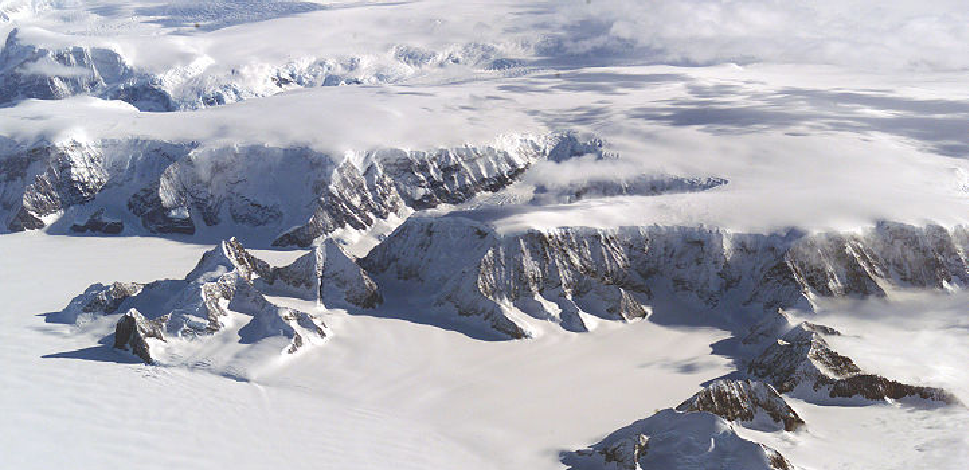
Lawrence Ice Shelf. Image: NASA
Along about half of Antarctica’s coast, floating shelves of ice protrude out into the water. Ice streams, or glaciers, flow downhill from the interior to the coast, and when the ice reaches the sea, it floats. These ice shelves are still connected to ice sheets on land, but they rise and fall with the tide. Ice also forms on the surface of the sea.
When you hear “sea ice” you may imagine icebergs, but they’re two different things. Icebergs are chunks of glaciers that have broken off and floated out to sea; they’re several kilometres thick, and they’re usually made of fresh water (Antarctica’s ice sheet holds over 60 per cent of the world’s fresh water).
Sea ice, on the other hand, is exactly what it sounds like: sheets of frozen sea water, usually just a few metres thick. During the South Pole winter, the seas freeze until the ice covers an area of ocean nearly the size of the continent itself. At the end of winter, the ice begins to recede, although some sea ice lingers around the coast through the summer.
Life in Antarctica depends on the sea ice. Ice means shelter and security, and it’s a substrate for life. Krill larvae hide from predators and forage on algae on the underside of floating sea ice, and several species of penguins and seals live, hunt, and breed on that ice. Krill are also at the base of the food web for other Southern Ocean predators, from seals to whales, so declining sea ice potentially threatens the entire ecosystem.
“If you lose the sea ice, then you’ve lost essential habitat for a very important species at the base of the food web for all the penguins,” said NOAA biologist Jefferson Hinke. “You’re going to lose the ability of the krill to really reproduce, and then all of your predators that are dependent on that particular prey suddenly are left with a big hole in their diet as well.”
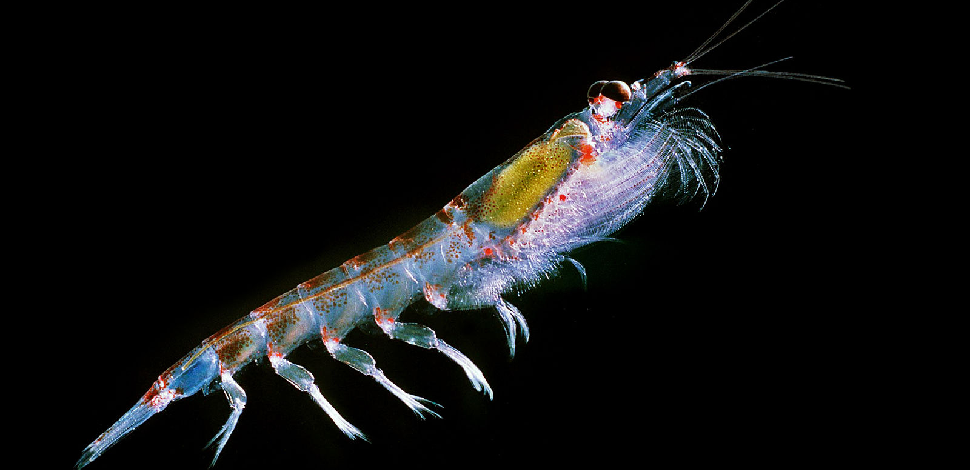
Antarctic krill. Image credit: Uwe Kils
Stormy Seas Ahead
Much of the region’s sensitivity to climate change is due to the Antarctic Peninsula, an 1287km strip of land that stretches northward into the Southern Ocean. Antarctica’s isolation protects most of the continent; it’s surrounded by the cold waters of the Southern Ocean, whose current flows in a swift circle around Antarctica, uninterrupted by land. These are some of the most violent, stormy waters in the world, but for Antarctica, they act as a buffer.
“I kind of think of it as like a big cushion: the mere fact that Antarctica is an isolated land mass surrounded by these oceans and very strong strong winds,” said paleoclimate researcher Elizabeth Thomas of Cambridge University and the British Antarctic Survey. But the Antarctic Peninsula sticks out into the Southern Ocean, catching the full force of the wind and the sea.
We are now seeing a shift in weather patterns. It’s the product of a complex set of interactions between atmospheric systems, but the root cause is warmer water thousands of miles away — and, of course, the root cause of that is greenhouse gas emissions. “Changes in sea level pressure in the tropical Pacific, changes in sea surface temperatures in the tropical and western Pacific, do seem to be closely related to changes in precipitation in this part of west Antarctica,” said Thomas.
The El Niño Southern Oscillation, a climate pattern fuelled by periodic changes in water temperature in the tropical Pacific, helps move that warmer water southward. In the process, it interacts with the Southern Annular Mode, a belt of westerly winds that periodically shifts from north to south. When the SAM is in its “positive” phase, the winds shift south, carrying more low pressure systems and storms to Antarctica. In particular, there has been an increase in storm activity in a stormy low pressure system called the Amundsen Sea Low, near the base of the Peninsula.
Vanishing Sea Ice
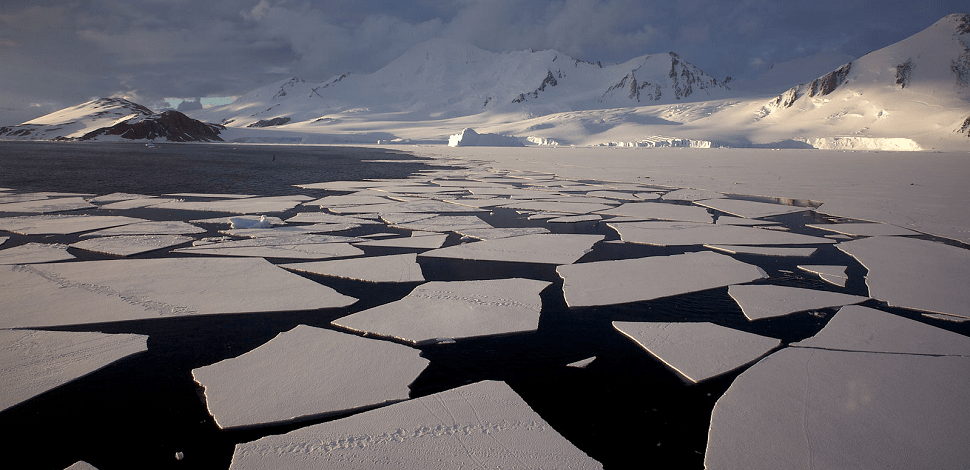
Antarctic sea ice. Image: Jason Auch
That warmer water means sea ice forms later in the season, doesn’t cover as much of the ocean, and melts sooner than it used to. So although the rest of the continent has been slowly gaining sea ice in recent years, it has been on the decline in western Antarctica. In that respect, the big picture doesn’t tell the whole story.
“Very often, people refer to Antarctic sea ice as one thing. You’ll hear people report ‘Antarctic sea ice is increasing,’ and that’s because they’re combining all the sea ice in all the different sectors and coming up with a trend, although it’s actually quite small,” said Thomas. “But there’s very, very big regional differences. So, Antarctica is huge, the Southern Ocean is huge, and there’s big differences between what’s happening in the Bellingshausen Sea, which is just adjacent to the Antarctic Peninsula, and what’s happening in the Ross Sea.” Around the Bellingshausen Sea, sea ice has been declining since the early 20th century.
Thinning Ice Shelves
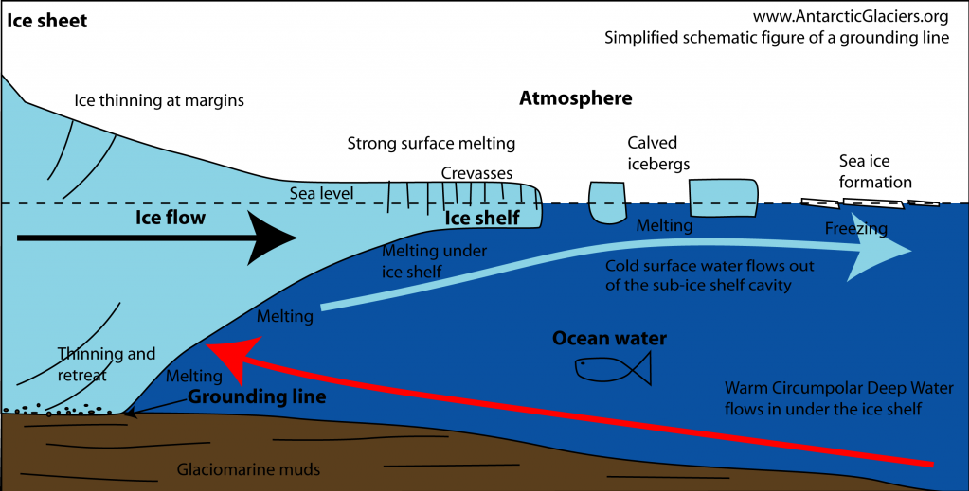
Diagram of an ice shelf. Image: www.AntarcticGlaciers.org
The coastal ice shelves of West Antarctica are melting away, too. When warm water reaches the bases of floating ice shelves, it melts the ice from the bottom up, in what’s called basal melting. Antarctica’s ice shelves have always experienced some basal melting, but not nearly as much as today. Until recent decades, snowfall accumulation was enough to replace the small amount of ice lost to basal melting each year, so the ice shelves stayed about the same size — but as melting speeds up, snowfall can’t build up fast enough to replace the ice.
That’s despite the fact that West Antarctica is receiving more snowfall than it used to. Ellsworth Land gets about 1.5m of snowfall accumulation every year, according to Thomas and her colleagues, which is about 33 per cent more than it received in the early 1900s. Her team studied 300-year ice core records from three glaciers in West Antarctica, and found that precipitation rates in the area had been pretty stable from 1700 to 1900, then started to increased throughout the 20th century. The change accelerated significantly starting in the late 1970s.
The same storms that are bringing warm water to the base of West Antarctica’s ice shelves are also bringing more moisture, and that means more snow — lots of it. “Sea ice acts as a big lid to the ocean, so you’re effectively putting a big film over the ocean… which prevents moisture uptake from the surface of the ocean,” said Thomas. “Less sea ice is like taking the lid off the ocean and allowing us to get access to that surface level moisture.”
Yet some of the region’s ice shelves, like the Pine Island glacier, are melting so quickly that even 1.5m of snow a year isn’t enough to replace the lost ice. So ice shelves get thinner, and the grounding line — the point where the ice shelf stops resting on the bedrock and begins floating — gets pushed further back. That makes the shelves unstable, and eventually, they can collapse.
We’ve already seen what that looks like. In 2002, an ice shelf the size of Rhode Island collapsed into the Southern Ocean. It had been sheltering an underwater ecosystem of chemotrophic microbes clustered around seafloor vents 800m below the surface.
The processes that are changing West Antarctica’s coastline are expected to continue over the next century. “Certainly all the evidence seems to be suggesting that we’re going to get this strengthening in the winds [the circumpolar westerlies],” said Thomas. “You’re going to be getting more onshore winds that are going to be driving this melting of warm water reaching the tongues of the glaciers. I’m guessing that as we go into the future, we’re going to start seeing more ice shelf collapse.”
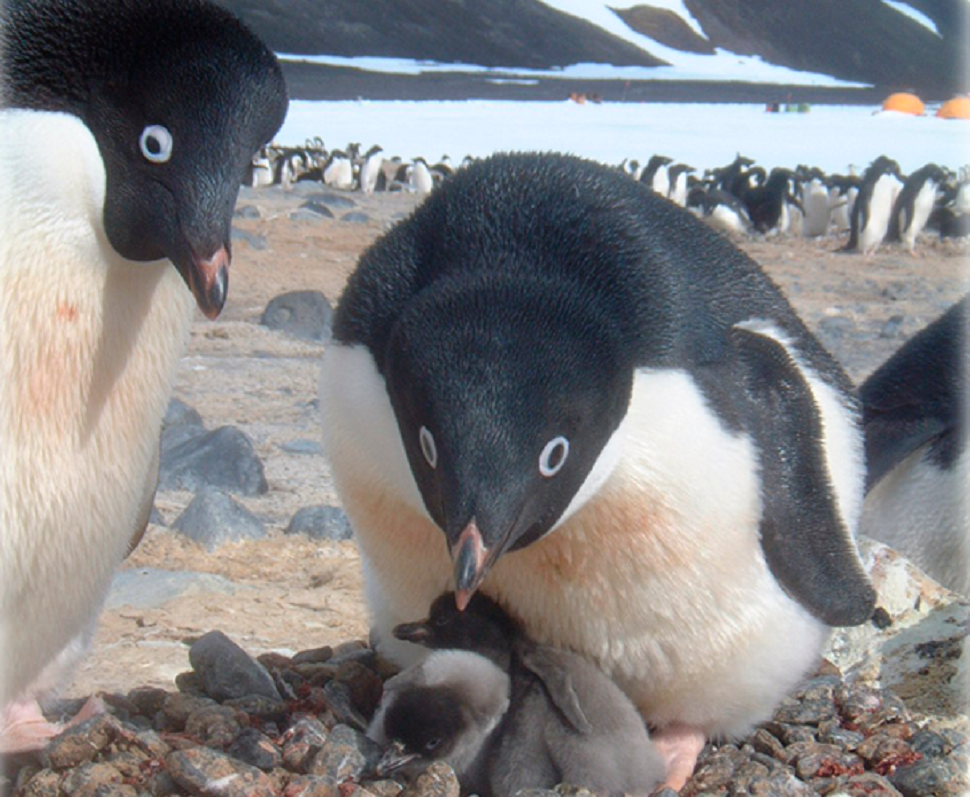
Adelie penguins. Image: Chown SL, Sinclair BJ, Leinaas HP, Gaston KJ: Hemispheric Asymmetries in Biodiversity — A Serious Matter for Ecology. PLoS Biol.
The Future of the South Pole
That could mean big changes for Antarctica’s ecosystem. Unless they can adapt quickly, species that rely on the ice as a place to forage and breed could disappear from the Peninsula region as their habitat changes. “Crabeater seals and Adelie penguins are extremely vulnerable,” said NOAA pinniped researcher Mike Goebel. “If the ice disappears, based on what we know of their distributions today, they will decline and disappear.”
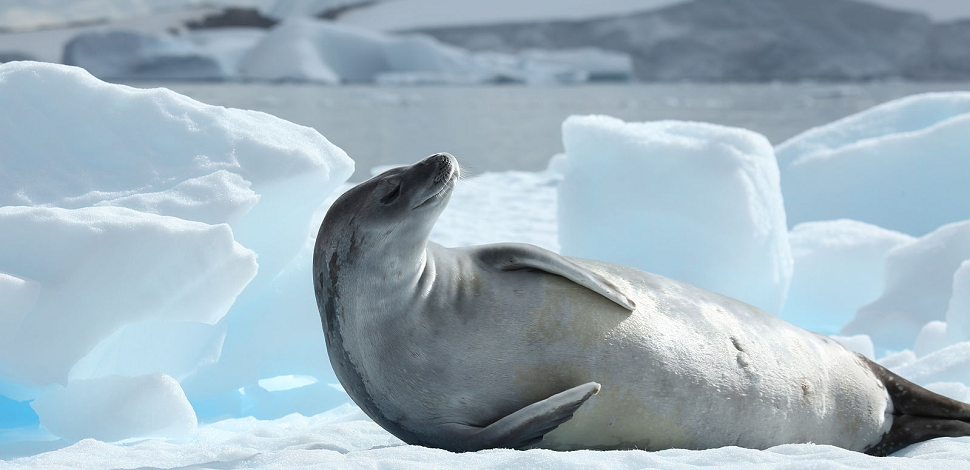
Crabeater seal. Image: Liam Quinn
Adelie penguins are already declining. “It’s not like they’re going to disappear entirely, but I would expect that their populations continue to decline in the Peninsula region, at least for the foreseeable future,” said Hinke.
Greater snowfall makes matters worse. “For species like [Adelie] penguins that breed on land and have to build nests from rocks, when it snows, those get covered, and then the birds show up and their nest sites aren’t anywhere to be found,” he said. “In which case, they just melt little tubes of snow into the bottom of a snow bank, and their eggs freeze, and therefore fail, or they get buried in their nests.” As a result, the number of chicks Adelie penguin breeding colonies produce varies strongly from year to year, and it remains to be seen whether the birds will adapt their breeding cycles or nesting habits to the new realities of West Antarctic weather.
But one species’ loss is sometimes another species’ gain. Gentoo penguins are moving into some of the territory opened up by the receding ice. Gentoos usually live further north, but they have recently been moving into nesting grounds on the Peninsula. If the sea ice continues to disappear in West Antarctica, ecologists could see Gentoo penguins replacing Adelie and chinstrap penguins in the region. “It’s an interesting mix of some benefitting and some not benefitting from the changes that are occurring,” said Hinke.
Other northern species aren’t so lucky. Fur seals share their range with the Gentoo, but their numbers have actually declined in recent years — mostly because leopard seals have been eating them. Leopard seals hunt on sea ice for a mixed diet of krill and young crab eater seals. “But because the ice has receded, they appear to be preying more on fur seal pups, and because of that fur seals are declining,” said Goebel.
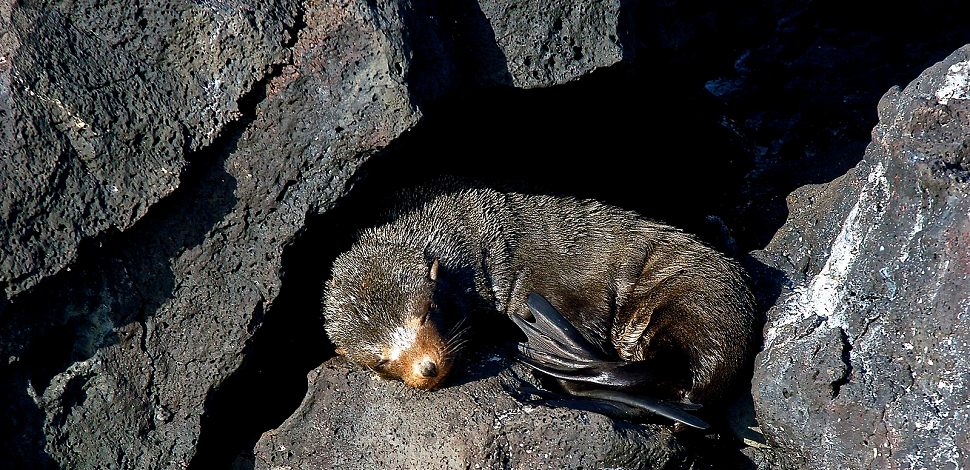
Sleepy fur seal pup. Image: Les Williams
That’s because crab eater seals, like leopard seals, only breed and give birth on sea ice; it’s also the only place they hunt. Leopard seals may have a better chance; they can haul out on land and hunt krill from shore. “But nobody’s ever seen them breed or pup on land,” said Goebel. Their fate may depend on whether they can pick up the habit.
And if the krill vanish with the sea ice, many of Antarctica’s predators — not to mention the world’s already-endangered whale populations — could be in serious trouble.
An Ice-Free Future?
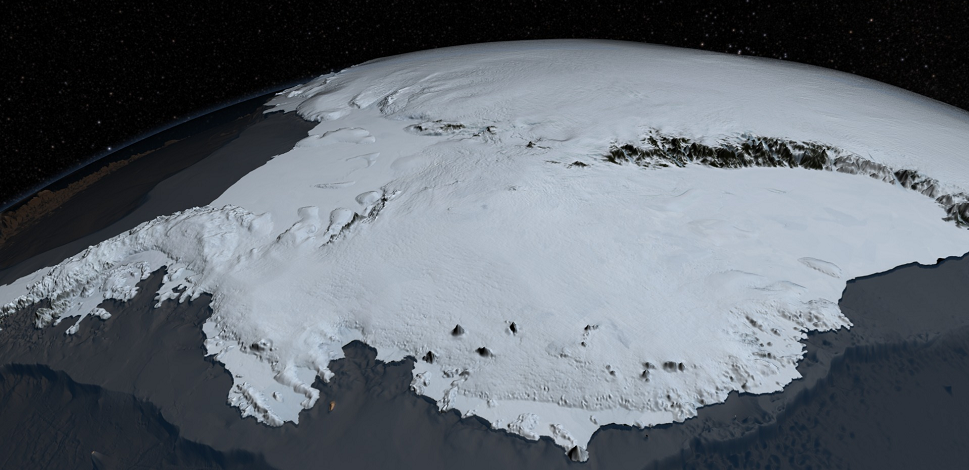
Antarctica. Image: NASA
What will West Antarctica look like a century from now? It will probably be slightly warmer; average temperatures on the continent have increased about 0.5C every decade since the 1940s, and that trend shows no signs of reversing or slowing. And it will probably be snowier and stormier, with less predictable weather patterns.
Much of the sea ice that now surrounds the western coast during the winter months will be absent a hundred years from now, and many of West Antarctica’s ice shelves will be in danger of collapse; some may have already broken up, contributing to a rising global sea level. Some species will have vanished from the region, either due to extinction or migration, and other species will have moved in. But East Antarctica, buffered by the Southern Ocean, may not look much different from today.
Ultimately, the fate of the continent depends on people living several thousand miles away. The world leaders meeting in Paris this week are hoping to make a deal that will change things sufficiently to keep global average temperatures from rising more than 2C above what they were before the Industrial Revolution. Even if that goal is achieved, most of the West Antarctic Ice Sheet will still become unstable in the next century, according to a modelling study by climate researcher Ricarda Winkelmann and her colleagues, published earlier this year in the journal Science Advances.
The good news is that most of eastern Antarctica’s sheets will remain stable, thanks to the relative protection of the Southern Ocean’s currents. But if we miss the 2⁰ target, the Wilkes Basin — an area on the opposite side of the continent from the Antarctic Peninsula — could start losing its ice rapidly.
Some observers say that what’s happening in West Antarctica today could be a preview of how the eastern half of the continent could respond to similar changes if global warming continues unchecked. That’s especially true of the animals that inhabit the icy landscape. “The kinds of changes in when they breed, their reproductive success, the changes in weather patterns that occur because of warming air temperatures and warming oceans – those kinds of things, I think, are good precursors,” said Hinke. “It probably won’t map on directly, but it does provide a little bit of a future glimpse.”
But Thomas contends that West Antarctica isn’t an exact model for the fate of the rest of the continent. “I think it would be alarmist to say that what’s happening in the Antarctic Peninsula is evidence of what’s going to happen to the rest of the continent,” she said. “Because it is so huge, and there are so many other factors that I think any changes in, especially, east Antarctica are going to be very slow indeed.”

Antarctica’s bedrock, beneath the ice. Image: NASA
Yet slow changes still matter. There are about 10,000 gigatonnes of carbon left in the world’s fossil fuel reserves, and Winkelmann’s study predicts that if we burn it all, Antarctica would be bare bedrock in a few thousand years. As she and her colleagues wrote, “Our results show that the currently attainable carbon fuel resources are sufficient to eliminate the Antarctic Ice sheet.”
Top image: Christopher Michel
